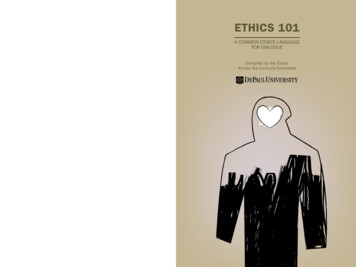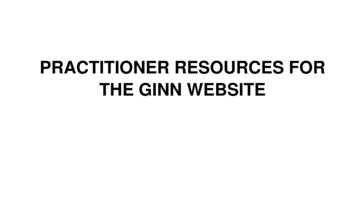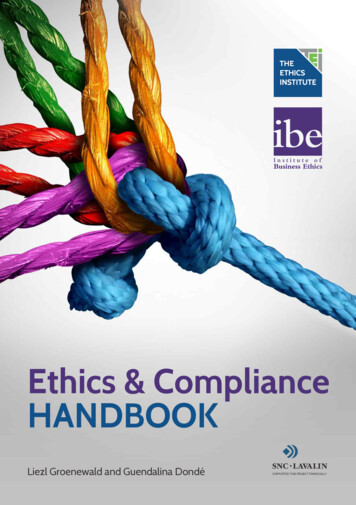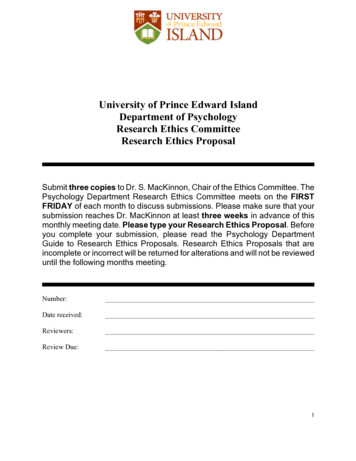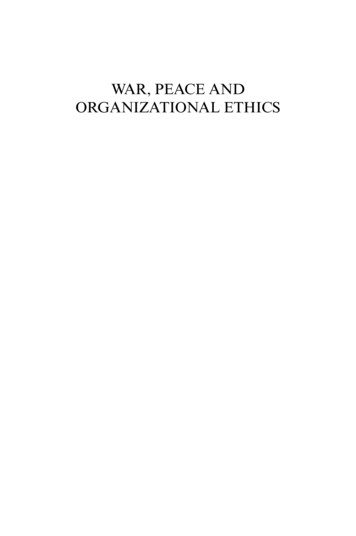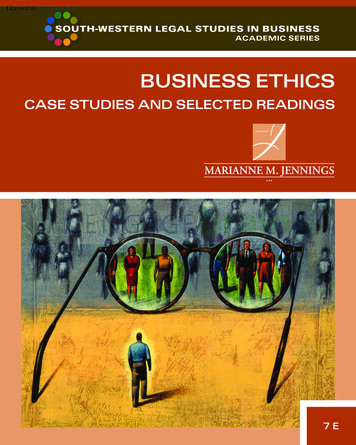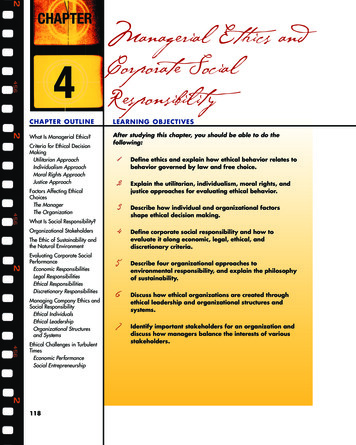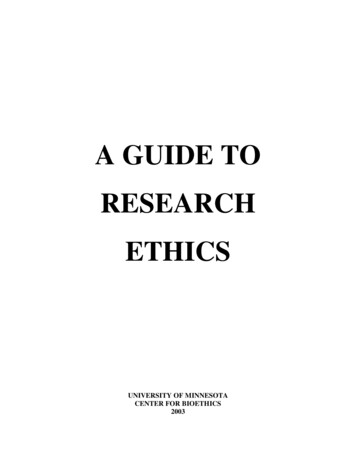
Transcription
A GUIDE TORESEARCHETHICSUNIVERSITY OF MINNESOTACENTER FOR BIOETHICS2003
TABLE OF CONTENTSBACKGROUND AND DEFINITION . . Page 3RESEARCH ETHICS ISSUESAuthorship . . Page 8Plagiarism . Page 11Peer review . . Page 15Conflicts of interest . . Page 19Data management Page 22Research misconduct . Page 27Research with animals . Page 31Research with human subjects . Page 35GLOSSARY OF CLINICAL TRIAL TERMS . Page 43REFERENCES Page 512
RESEARCH ETHICS:BACKGROUND AND DEFINITIONDEFINITIONResearch ethics provides guidelines for the responsible conduct of biomedicalresearch. In addition, research ethics educates and monitors scientists conductingresearch to ensure a high ethical standard.BRIEF HISTORYThe birth of modern research ethics began with a desire to protect human subjectsinvolved in research projects. The first attempt to craft regulations began during theDoctors Trial of 1946-1947. The Doctors Trial was asegment of the Nuremberg Trials for Nazi war criminals(see photo*). In the Doctors Trial, 23 German Naziphysicians were accused of conducting abhorrent andtorturous “experiments” with concentration campinmates. The accused physicians tortured, brutalized,crippled, and murdered thousands of victims in the nameof research. Some of their experiments involvedgathering scientific information about the limits of thehuman body by exposing victims to extremetemperatures and altitudes. The most gruesome anddestructive experiments tested how quickly a humanPhoto of the NurembergPalace of JusticePhoto by: Thomas J. Dodd Papers,Dodd Research Center, UniversityLibraries, University of Connecticutcould be euthanatized in order to carry out the Naziracial purification policies most efficiently.To prosecute the accused Nazi doctors for the atrocities they committed, a list ofethical guidelines for the conduct of research – the Nuremberg Code – were developed.*Thomas J. Dodd Papers website. tm. Accessed2/05/03.3
The Nuremberg Code consisted of ten basic ethical principles that the accused violated.1The 10 guidelines were as follows:1. Research participants must voluntarily consent to researchparticipation2. Research aims should contribute to the good of society3. Research must be based on sound theory and prior animal testing4. Research must avoid unnecessary physical and mental suffering5. No research projects can go forward where serious injury and/ordeath are potential outcomes6. The degree of risk taken with research participants cannot exceedanticipated benefits of results7. Proper environment and protection forparticipants is necessary8. Experiments can be conducted only byscientifically qualified persons9. Human subjects must be allowed todiscontinue their participation at any time10. Scientists must be prepared to terminate the experiment if thereis cause to believe that continuation will be harmful or result ininjury or deathThe Nuremberg Guidelines paved the way for the next major initiative designedto promote responsible research with human subjects, the Helsinki Declaration. TheHelsinki Declaration was developed by the World Medical Association and has beenrevised and updated periodically since 1964, with the last update occurring in 2000.2 Thedocument lays out basic ethical principles for conducting biomedical research andspecifies guidelines for research conducted either by a physician, in conjunction withmedical care, or within a clinical setting.The Helsinki Declaration contains all the basic ethical elements specified in theNuremberg Code but then advances further guidelines specifically designed to address4
the unique vulnerabilities of human subjects solicited to participate in clinical researchprojects. The unique principles developed within the Helsinki Declaration include: The necessity of using an independent investigator to review potential researchprojects Employing a medically qualified person to supervise the research and assumeresponsibility for the health and welfare of human subjects The importance of preserving the accuracy of research results Suggestions on how to obtain informed consent from research participants Rules concerning research with children and mentally incompetent persons Evaluating and using experimental treatments on patients The importance of determining which medical situations and conditions areappropriate and safe for researchFollowing the Helsinki Declaration, the next set of research ethics guidelinescame out in the Belmont Report of 1979 from the National Commission for theProtection of Human Subjects of Biomedical and Behavioral Research. The reportoutlines:1. The ethical principles for research with human subjects2. Boundaries between medical practice and research3. The concepts of respect for persons, beneficence, and justice4. Applications of these principles in informedconsent (respect for persons), assessing risks andbenefits (beneficence), and subject selection(justice)3The Nuremberg, Helsinki, and Belmont guidelines provided the foundation ofmore ethically uniform research to which stringent rules and consequences for violationwere attached. Governmental laws and regulations concerning the responsible conduct ofresearch have since been developed for research that involves both human and animal5
subjects. The Animal Welfare Act provides guidelines and regulations for research withanimals. It goes into detail about sale, licensure, facilities, transport, and other careinstructions. For research with human subjects Title 45, Part 46 from the Code ofFederal Regulations (45 CFR 46): The Protection of Human Subjects Regulationsoutlines the purpose and policies of Institutional Review Board (IRB) oversight andapproval, informed consent, and protections and policies for research with children,pregnant women, fetuses, prisoners, and mentally incompetent individuals.Currently, the focus of research ethics lies in the education of researchersregarding the ethical principles behind regulations as well as the oversight and review ofcurrent and potential research projects. The field has expanded from providingprotections for human subjects to including ethical guidelines that encompass all parts ofresearch from research design to the truthful reporting of results.There are several avenues for people who wish to seek education on basic ethicalprinciples, and avenues for education on how to comply with policies at the institutional,state, and national levels. The University of Minnesota’s Center for Bioethics(www.bioethics.umn.edu) and many other universities and professional associationsaround the country continually offer education for researchers and scientists on ethicalresearch issues. Curriculum is available in frequently offered conferences, classroomsettings, and on-line (www.research.umn.edu/curriculum).WHY STUDY RESEARCH ETHICS?Knowing what constitutes ethical research is important for all people who conductresearch projects or use and apply the results from research findings. All researchersshould be familiar with the basic ethical principles and have up-to-date knowledge aboutpolicies and procedures designed to ensure the safety of research subjects and to preventsloppy or irresponsible research, because ignorance of policies designed to protectresearch subjects is not considered a viable excuse for ethically questionable projects.Therefore, the duty lies with the researcher to seek out and fully understand the policiesand theories designed to guarantee upstanding research practices.Research is a public trust that must be ethically conducted, trustworthy, andsocially responsible if the results are to be valuable. All parts of a research project – from6
the project design to submission of the results for peer review – have to be upstanding inorder to be considered ethical. When even one part of a research project is questionableor conducted unethically, the integrity of the entire project is called into question.7
AUTHORSHIPDEFINITION AND IMPORTANCEAuthorship is the process of deciding whose namesbelong on a research paper. In many cases, research evolvesfrom collaboration and assistance between experts andcolleagues. Some of this assistance will requireacknowledgement and some will require joint authorship.4Responsible authorship practices are an important part of research. Reporting andanalyzing results is the key to applying research findings to the real world. Despite itsvital role, authorship remains a murky and vague area for many scientists who frequentlyrun into difficulty when deciding which colleagues should be listed as authors or coauthors, and which colleagues should instead receive acknowledgement. Despite thechallenges, researchers should familiarize themselves with proper authorship practices inorder to protect their work and ideas while also preventing research fraud.ETHICAL GUIDELINESEach person listed as an author on an article should have significantly contributedto both the research and writing. In addition, all listed authors must be prepared to acceptfull responsibility for the content of the research article. The International Committee ofMedical Journal Editors (ICMJE) is the recognized international expert organizationwhen it comes to guidelines regarding biomedical research authorship. Their website(www.icmje.org) lists all requirements for authorship, which are quoted as follows:Authorship credit should be based only on 1) substantial contributions toconception and design, or acquisition of data, or analysis andinterpretation of data; 2) drafting the article or revising it critically forimportant intellectual content; and 3) final approval of the version to be8
published. Conditions 1, 2, and 3 must all be met. Acquisition of funding,the collection of data, or general supervision of the research group, bythemselves, do not justify authorship.5According to the ICMJE, colleagues who are part of a research group or team butdo not meet the conditions above should NOT be listed as authors. They should insteadreceive acknowledgement at the end of the manuscript, with a brief description of theircontribution if appropriate. In order to acknowledge a contributing colleague, thecolleague must consent to the acknowledgement, lest they seem to be endorsing researchor conclusions drawn from research for which they are not responsible.6All the contributing co-authors of an article must jointly decide the order of thelisting of names. The first person listed should be the person most closely involved withthe research.7 The authors should then decide the order of the remaining authors inaccordance with the criteria of the publishing journal, and be prepared to answerquestions about why the order is as it appears.“Can I be a co-author?”“Sure! But only if you 1. Contributed substantially to the research, AND 2. Wrote or revised all or part of the manuscript, AND 3. Approved the final version of the entire article.” Guidelines from the ICMJEwebsite at www.icmje.orgEXAMPLE CASE STUDYQuery Jamal is a graduate student working under the supervision of professor, Dr.Kerry. Dr. Kerry is conducting research on tooth decay and has gathered data fromhundreds of dental patients. Jamal uses Dr. Kerry’s data to analyze a research questionthat he came up with on his own about tooth enamel erosion. His question is his ownidea, but is still based on what he learned about tooth and enamel decay under Dr. Kerry.9
Jamal’s friend, Darcie, helped Jamal design a statistical computer program for dataanalysis, but did not contribute in any other way to the research. When writing up hisresults, Dr. Kerry helped Jamal write the methods section of his manuscript and reviewedhis final results and conclusions, as well as the final draft of the entire manuscript. Howshould authorship be decided in this case?Answer Jamal should be listed first as the primary author because he is mostclosely involved in the research project. Dr. Kerry should be listed second as co-authorbecause she meets the ICJME requirements of authorship. Darcie does not meet thecriteria for authorship, but she should be acknowledged for her contribution if she soconsents.UNIVERSITY OF MINNESOTA RESOURCES AND GUIDELINES8 University of Minnesota Code of Conduct for researchers (Section 2, Subdivisions 4and 5) available online onduct.html University of Minnesota Publication of Investigation istrative/PublicationofResults.html On-line curriculum on authorship issues by Mark Dworkin available at:www.research.umn.edu/ethics. Click on “curriculum,” then “authorship”.OTHER RESOURCES AND GUIDELINES The International Committee of Medical Journal Editors has a variety of helpful hintson a range of research ethics topics, including authorship. www.icmje.org. The following article suggests how to organize authorship when research is conductedin more than one institution.Barker A. Powell RA. Authorship. Guidelines exist on ownership of data andauthorship in multicentre collaborations. British Medical Journal, 1997;314(7086):1046.10
PLAGIARISMDEFINITION AND IMPORTANCEPlagiarism is the act of passing off somebody else’s ideas, thoughts, pictures,theories, words, or stories as your own. If a researcher plagiarizes the work of others,they are bringing into question the integrity, ethics, and trustworthiness of the sum totalof his or her research.9 In addition, plagiarism is both an illegal act and punishable,considered to be on the same level as stealing from the author thatwhich he or she originally created.Plagiarism takes many forms. On one end of the spectrumare people who intentionally take a passage word-for-word, put it intheir own work, and do not properly credit the original author. Theother end consists of unintentional (or simply lazy) paraphrased andfragmented texts the author has pieced together from several works without properlyciting the original sources.10,11 No part of the spectrum of potential plagiaristic acts aretolerated by the scientific community, and research manuscripts will be rejected bypublishers if they contain any form of plagiarism – including unintentional plagiarism.ETHICAL GUIDELINESThe Indiana University website provides the following advice to avoid plagiarism.A researcher preparing a written manuscript should cite the original source if he or she: “Quotes another person’s actual words, either oral or written; Paraphrases another person’s words, either oral or written; Uses another person’s idea, opinion, or theory; or Borrows facts, statistics, or other illustrative material, unless the information iscommon knowledge.”1211
The rules of plagiarism typically apply to graphics, text, and other visuals from alltraditional forms of publication and include modern forms of publications as well, inparticular the World Wide Web. If a substantial amount of another person’s graphics ortext will be lifted from a web page, an author should ask permission to use the materialfrom the original author or website host.13Most researchers certainly try not to plagiarize. However, it isn’t always easybecause people often consult a variety of sources of information for their research andend up mixing it in with their own background knowledge.14 To avoid unintentional oraccidental plagiarizing of another person’s work, use the following tips from theNorthwestern University website: Cite all ideas and information that is not your own and/or is not commonknowledge, Always use quotation marks if you are using someone else’s words, At the beginning of a paraphrased section, show that what comes next is someoneelse’s original idea (example: these bullet points start out by saying the informationoriginated with Northwestern University), At the end of a paraphrased section, place the proper citation.15Redundant publications constitute a special type of plagiarism. The ICMJEdefines redundant publication as follows:“Redundant or duplicate publication is publication of a paper thatoverlaps substantially with one already published.”16The ICMJE further points out that resubmitting a manuscript to a journal when ithas already been published elsewhere violates, “international copyright laws, ethicalconduct, and cost-effective use of resources.” Articles that have been published alreadyshould not be either resubmitted under another title, or resubmitted with only minorchanges to the text unless it is clearly stated that it is a resubmitted article.1712
EXAMPLE CASE STUDYQuery Belinda is publishing her first article that builds on the research of a similarproject she did three years prior with her colleague, Isaiah. In Belinda’s current articleshe has placed a graph from the article she and Isaiah co-authored about their previousresearch. Isaiah created the original graph. Does Belinda have to site the previousarticle?Answer Yes. Belinda is using the ideas of another person(s). Even though thegraph came from an article she herself worked on, she should appropriately cite the priorpublication to show that: a) the data and results depicted in the graph are not new andhave been previously published; and, b) the idea originated with another entity (in thisinstance the other entity is the research team of Belinda and Isaiah).UNIVERSITY OF MINNESOTA RESOURCES AND GUIDELINES18 The University of Minnesota does not condone plagiarism. Plagiarism violatesuniversity policy and is not tolerated. For guidelines and Code of Conduct information,try the University of Minnesota’s Office of Vice President of Research’s website atwww.research.umn.edu.OTHER RESOURCES AND GUIDELINES The website www.plagiarism.org has been recommended by some researchers as away to improve the quality of peer reviewed research publications. The website has adatabase of publications and can be used to detect plagiarism in a submittedmanuscript.19 The International Committee of Medical Journal Editors’ website at www.icmje.org hasresources on plagiarism and other ethical research issues, including how to referenceall types of literature.13
Proper citation and referencing procedures can be obtained from the ModernLanguage Association’s guidebook, MLA Style Manual and Guide to ScholarlyPublishing. (2nd Edition) Joseph Gibaldi, ed., 1998. This guidebook is for graduatestudents, academicians, and professionals. For undergraduate students, proper citation guidelines are outlined in the MLAHandbook for Writers of Research Papers. (5th Edition) Joseph Gibaldi, ed., 1999. A reference article concerning plagiarism:Price AR. Federal Actions against Plagiarism in Research. Journal of InformationEthics, 1996; 5(1):34-51. Another article about plagiarism and the Internet:Eysenbach G. Report of a case of cyberplagiarism--and reflections on detecting andpreventing academic misconduct using the Internet. Journal of Medical InternetResearch, 2000; 2(1):E4.14
PEER REVIEWDEFINITION AND IMPORTANCEPeer review is the process in which an author (or authors) submits a writtenmanuscript or article to a journal for publication and the journal editor distributes thearticle to experts working in the same, or similar, scientific discipline. The experts,otherwise called the reviewers, and the editor then enter the peer review process. Theprocess involves the following:1. Reviewers and editors read and evaluate the article2. Reviewers submit their reviews back to the journal editor3. The journal editor takes all comments, including their own, andcommunicates this feedback to the original author (or authors)The peer review process seldom proceeds in a straight line. The entire processmay involve several rounds of communication between the editor, the reviewers, and theoriginal author (or authors) before an article is fully ready for publication.According to an article on quality peer reviews in the Journal of the AmericanMedical Association, a high quality peer review should evaluate a biomedical article orpublication on the following merits: Importance – Does the research impact health and health care? Usefulness – Does the study provide useful scientific information? Relevance – Does the research apply to the journal’s readers and content area ofinterest? Sound methods – Was the research conducted with sound scientific methodsthat allowed the researchers to answer their research question?15
Sound ethics – Was the study conducted ethically ensuring proper protection forhuman subjects? Were results reported accurately and honestly? Completeness – Is all information relevant to the study included in the article? Accuracy – Is the written product a true reflection of the conduct and results of theresearch?20ETHICAL GUIDELINESThe two most important ethical concepts in the peer review process areconfidentiality and protection of intellectual property. Reviewers should not know theauthor (or authors) they are reviewing, and the author (or authors) should not be told thenames of the reviewers. Only by maintaining strict confidentiality guidelines can thepeer review process be truly open and beneficial. Likewise, no person involved in thepeer review process – either the editor, reviewers, or other journal staff – can publiclydisclose the information in the article or use the information in a submitted article forpersonal gain.Peer reviewers, in addition to maintaining confidentiality, can be neitherconflicted nor political in their review. Conflicts may take the form of financial conflictswith the results, conflicts if the research is too similar to their own research endeavors,and conflicts due to personal relationships with the author (or authors). Politicalmotivations that might interfere with the peer review process include competition topublish with other scientists and inaccurate reviews designed to “punish” a competingcolleague or journal.21Editors may find it difficult to guarantee a conflict-free peer review process,because reviewers must be experts with knowledge unique to the field to which the articlepertains. Therefore, many reviewers may find themselves faced with an articleconcerning research that is very similar to their own. Peer reviewers should disclose allconflicts of interest that may unduly influence their review to the journal editor anddisqualify themselves when appropriate.Editors of journals should maintain an open and ethical peer review process, andall submitting authors and readers should be fully aware of a journal’s process of peer16
review. Editors do retain flexibility in assigning the number of peer reviewers and whatto do with the peer review information once completed. One method is for an editor toapproach two or three reviewers and then ask an author (or authors) to change the articleto satisfy all the reviews. On the other hand, an editor may take all the reviews andconsolidate the advice to help guide the author (or authors) when making changes,clarifications, and corrections.Editors must not relinquish too many of their own responsibilities to peerreviewers. The peer review process represents one step in the publishing process andeditors need to take full responsibility for their decision to include an article in theirjournal. This means that editors must review the content and character of a submittedarticle, using all the criteria listed for reviewers above, and should rely on the reviewersprimarily to catch errors that lie outside the editor’s area of expertise and technicalunderstanding.22Finally, editors should have full and complete freedom over the content of apublished journal. They should only include articles that they believe to be honest,accurate, ethical, and scientifically responsible. According to the InternationalCommittee of Medical Journal Editors, all editors have:“An obligation to support the concept of editorial freedom and to drawmajor transgressions of such freedom to the attention of the internationalmedical community.”23EXAMPLE CASE STUDYQuery Dr. Connelly is a faculty member at Springer University. He has beenasked to review a publication for a biomedical journal. After receiving the article, herealizes the author is a student working under the guidance of a fellow faculty member ina neighboring department. The faculty member happened to mention the merits of thestudent at a recent social gathering. Does Dr. Connelly have a reportable conflict ofinterest?17
Answer The peer review process relies on a foundation of confidentiality. Dr.Connelly should contact the journal editor and report his belief that the manuscriptoriginated from the university where he is employed. He and the editor should then opena dialogue about how this could potentially effect his participation in the peer reviewprocess and how to proceed.UNIVERSITY OF MINNESOTA RESOURCES AND GUIDELINES24 The University of Minnesota’s Board of Regents’ guidelines regarding intellectualproperty can be found on-line ntellectualProperty.pdfOTHER RESOURCES AND GUIDELINES The International Committee of Medical Journal Editors website at www.icmje.org hasinformation on the peer review process.18
CONFLICTS OF INTERESTDEFINITION AND IMPORTANCEConflicts of interest arise when a person’s (or an organization’s) obligations to aparticular research project conflict with their personal interests or obligations. Forexample, a university researcher who owns stock in XYZ Pharmaceuticals is obligated toreport truthful and accurate data, but he might be conflicted if faced with data that wouldhurt stock prices for XYZ pharmaceuticals. Conflicts of interest are particularlyimportant to examine within the context of biomedical research because research subjectsmay be particularly vulnerable to harm.25A researcher should attempt to identify potential conflicts of interest in order toconfront those issues before they have a chance to do harm or damage. If conflicts ofinterest do exist, then the objectivity of the researcher and the integrity of the researchresults can be questioned by any person throughout the research review process – fromthe IRB review through the peer review phase. It is therefore imperative to addressconflicts of interest up front and discuss how to combat potential lack of objectivity,before the research is called into question. 26ETHICAL GUIDELINESThe “Objectivity in Research NIH Guide,” provides guidelines on howinvestigators receiving grants from the National Institutes of Health (NIH) should handleconflicts of interest. In essence, it suggests that investigators should:27 Disclose to their institution any major or significant financial conflicts of interestthat might interfere with their ability to conduct a research project objectively Disclose any such financial conflicts of interest of their spouses or dependentchildren19
The Title 42 Code of Regulations (42 CFR 50) section on conflicts of interestcontains the Responsibility of Applicants for Promoting Objectivity in Research for whichPHS Funding is Sought guidelines, which consist of the following regulations fororganizations receiving NIH funding: The organization must have, “a written and enforced administrative process toidentify and manage, reduce, or eliminate conflicting financial interests withrespect to research projects for which NIH funding is sought;” Before any NIH funds are spent, the organization must inform the Chief GrantsManagement Officer (CGMO) at the appropriate NIH office of any existing conflictsof interest and indicate that the conflict has been addressed, “by indicatingwhether the conflict has either been managed, reduced, or eliminated;” The organization has to identify and report any conflicts that arise during thecourse of NIH funded research; The organization has to comply with NIH requests for information on how anidentified conflict of interest has been handled.28The NIH recommends the following possible actions to help organizationsaddress conflicts of interest: “Public disclosure of significant financial interests; Monitoring of research by independent reviewers; Modification of the research plan; Disqualification from participation in all or a portion of the research funded by PHS; Divestiture of significant financial interests; or Severance of relationships that create actual or potential conflicts.”29Physician and other health care professional researchers may find themselvesfacing conflicts of interest in their duties towards research versus their duties towards thehealth and welfare of their patients. Clinical obligations to patients should always beconsidered above and beyond the obligations of research.20
EXAMPLE CASE STUDYQuery Dr. Garrath is a gynecological physician and an investigator on a researchproject for a pharmaceutical company testing a new topical treatment for a sexuallytransmitted disease that must be administered frequently and can cause itching andirritation. The company is paying her a rate of 2,000 per person enrolled. Does shehave a conflict of interest?Answer Yes. Dr. Garrath’s obligation to her patients has the potential to becompromised by her personal interests. While her job is to protect and promote herpatients’ welfare and health, at 2,000 per person enrolled, she might be tempted torecruit more people into the study for her personal financial benefit by encouraging herpatients to participate and downplaying the side-effects and burdens of participation.Dr. Garrath should very carefully evaluate whether this conflict of interest mightimpact her patients’ health and welfare and how to solve this potential conflict beforeagreeing to be an investigator. She should also report this potential conflict to the properadministration authority at the clinical site where she is practicing.30UNIVERSITY OF MINNESOT
1. Research participants must voluntarily consent to research participation 2. Research aims should contribute to the good of society 3. Research must be based on sound theory and prior animal testing 4. Research must avoid unnecessary physical and mental suffering 5. No research projects can go forward where serious injury and/or

